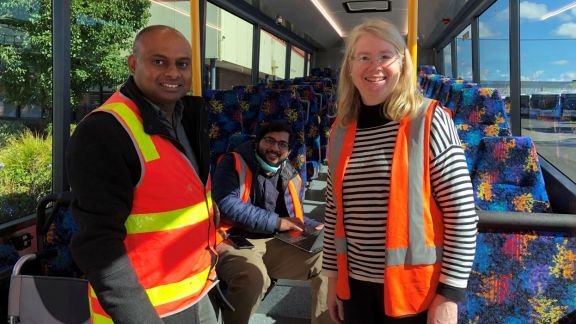New bus safety system promotes independence for travellers
27 May 2022

Federation University health and engineering researchers have developed a containment system to improve safety for passengers who use wheelchairs and mobility devices on buses without needing intervention from the driver.
The first phase roll-out of the wheelchair containment and restraint systems will be on up to 30 metropolitan low-floor buses across different routes to assess their effectiveness over several months. It is part of a $157.8 million package of works included in the Victorian Budget 2022/23, giving Victorians better access to public transport.
Professor of Occupational Therapy in the Institute of Health and Wellbeing Carolyn Unsworth said the project developed from a long relationship with Victoria's Department of Transport which has looked at ways to promote access and safety for people with disabilities on public transport.
The passive containment system, called MD-COB Options (Mobility Device — Containment On Bus Options), increases stability for passengers and does not require the bus driver to tie the person's mobility device to the bus floor.
"Buses travel deep into our communities and are essential in a connected transport system, but there are access problems, and there are also safety issues," Professor Unsworth said.
"If people are using their mobility devices on buses, when a bus travels around the corner or brakes suddenly, passengers can move around in their mobility devices, they can slide, and they can tip."
Professor Unsworth said a review of available safety systems from around the world found the two main designs in use were active tie-down systems – which tethered the mobility devices to the bus – and passive containment systems that face rearward and enable passengers to maintain their independence.
Professor Unsworth then teamed up with Mechatronics Senior Lecturer Gayan Kahandawa to test the different safety systems.
"The active tie-down systems are widely used in North America, and we know they work, but there are a lot of problems associated with them. People aren't independent anymore, and bus drivers have to get involved and crawl down on the floor to tie the devices down. These also create personal space invasion problems with bus drivers reaching across people to secure belts." Professor Carolyn Unsworth
"We then devised a study to look at the effectiveness of a passive rearward facing system. These are widely used across Europe, but we wanted to develop additional features to increase people's safety on the bus. We developed an additional lateral barrier that we want to test in the community."
In an Australian first, the researchers have also documented the forces that act on people when travelling in buses in the mobility devices, revealing the g-forces on people in different scenarios.
The researchers used on-bus sensors and complex 3D computer modelling to monitor the g-forces on passengers to identify the point at which passengers will slide and tip in different circumstances, and how different containment systems can reduce slide and tip.
"Now that we have this information, bus drivers who have a person on board in a wheelchair, mobility device or scooter can be very mindful of them when they have to take evasive action," Professor Unsworth said.
 "If a car pulls out in front of them and they have to brake harshly, they can't avoid it, but they will know the point that a person is in danger. However, they can prepare and modify their driving behaviour when going around a corner, for example.
"If a car pulls out in front of them and they have to brake harshly, they can't avoid it, but they will know the point that a person is in danger. However, they can prepare and modify their driving behaviour when going around a corner, for example.
"The ability to simulate these scenarios will be extremely useful in the future. And with this system that we developed, we completed pilot testing with mobility device uses to test out both an active tie-down system and then the new passive system that we developed to make comparisons."
Dr Kahandawa said the research included recording real-time data with sensors mounted on buses in metropolitan Melbourne, Gippsland, Geelong and the Mount Dandenong area.
"We have collected a lot of real-time information that we can directly apply to the simulation and then put a wheelchair on top of that in the software – this shows us how a person in their mobility device will move and when it's in danger of tipping," Dr Kahandawa said.
"Developing a 3D computer-based simulation to use with real-world testing allows us to verify the effectiveness of our system and others used around the world."
Professor Unsworth said there is considerable activity and interest in getting a better safety system on buses for people using mobility devices.
"Everything we are trying to do here is about safety and independence for the person in the mobility device, promoting independence and not getting bus drivers involved in the process," she said.
"This project has also been a happy marriage between health and engineering experts to solve a problem where individually we just couldn't. With health, we have the imperative for what needs to be solved, and we work with people with lived- experience to guide us on the strengths and limitations of evolving designs. With the engineering expertise, we can determine what is technically working best, what's the safest option for passengers and how we develop it."


